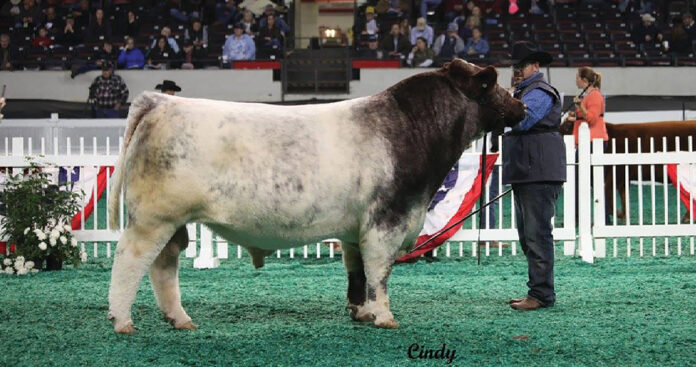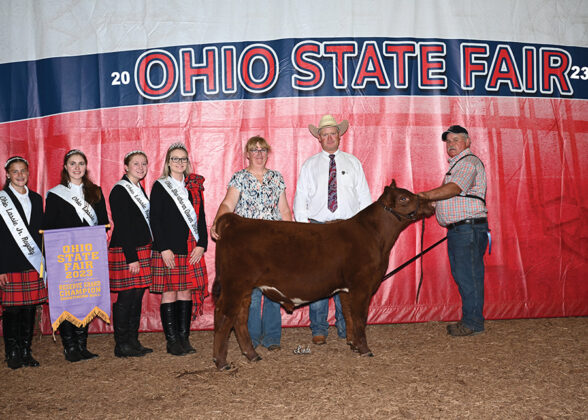
SALEM, Ohio — Jeff Winkle of Cedar Lane Farm in Cedarville, Ohio can trace a family history tied to Shorthorn cattle for over 100 years.
“My dad and my grandpa raised registered Shorthorn cattle,” Winkle said. “1912 is the earliest registration paper I can find that my grandpa was listed on.”
Winkle, 2023 Ohio Cattlemen’s Association Seedstock Producer of the Year and president of the Ohio Shorthorn Association, takes pride in the breed’s popularity.
“We are probably the largest association in the United States,” Winkle said. “And you’d be surprised to know that there are more Shorthorn breeders in Ohio than any other state — by quite a lot.”
Interspersed throughout 17,000 Ohio beef farms are some of the nation’s highest-quality producers of purebred cattle, or seedstock. Ohio beef genetics are represented nationally and internationally through the sales of purebred or registered bulls, cows, heifers, semen and embryos.
Seedstock production in the Ohio beef industry means different things to different people. Breeders are marketing to commercial producers who are looking for improved production, 4-H and junior fair participants focused on winning in the show ring and other breeders hoping to improve their herd and further propagate world-class genetics, said Elizabeth Harsh, Ohio Beef Council and Ohio Cattlemen’s Association Executive Director.
“Ohio is truly a seedstock mecca in this country — we have tremendous seedstock producers here in the state,” she said.
Growing interest
Winkle’s interest in seedstock production grew in college.
“I went to Ohio State and lived in the beef barn to get through college and met a lot of people that got me interested in the purebred seedstock industry,” he said.
After college, Winkle worked on a registered Charolais farm, followed by a stint on a registered Angus farm. It was then he and his wife decided to move to her family farm in Cedarville.
“We started out raising Angus part-time,” he said. “I’ve been a part-time operator all my life — I work off the farm. You’ll find out a lot of these purebred guys, that’s how a lot of us operate.”
Cedar Lane Farm’s herd numbers are about 35 with approximately 20 purebred females used for breeding through AI or bulls. His market includes high-quality embryos, heifers and heifer calves for junior fair projects.
“My goal is to have at least 80% of the calves we raise sold for breeding stock,” Winkle said.
Winkle’s passion for cattle and work ethic came from his father, who wanted to be a registered seedstock producer but could not afford it.
”He had a 260-acre farm that he farmed on the shares — that’s how he made his living,” Winkle said. “So, I wasn’t raised with a silver spoon or anything like that.”
Scale
Not all seedstock operations are equal. Some are very progressive and take it to the next level, Harsh said.
“A large part of their operation may be seedstock, but because they’ve got such value in the cattle’s genetics, not every animal will make the grade as a bull or replacement female. So, they may feed those animals in their feedlot, and sell that,” she said.
Maplecrest Farms in Hillsboro is an example of a successful operation that has capitalized on its genetic excellence by directly marketing its beef through Maplecrest Meats.
“They’re direct-marketing their beef products because it’s a Certified Angus Beef program,” Harsh said. “They have the resources and the size to be able to do that kind of thing — it takes numbers to be able to do that. A small operation with two or three dozen cows is not equipped to do that.”
Many farms are not full-time seedstock producers and rely on other sources of income, Harsh said. They might raise row crops like corn and soybeans or, like Winkle, work an off-farm job.
Marketing
Seedstock suppliers have multiple marketing platforms, including performance sales, consignment sales, online sales and private treaty sales.
Large farm production sales from an established brand with a record of success attract hundreds of buyers. However, smaller operations are marketing their genetics to a large audience via online sales.
“They may not be big enough to have their on-farm production sale, but they can still capitalize on marketing those genetics through online marketing,” Harsh said. “A small producer can do their online sale with just a handful of show heifers and they reduce a lot of that overhead.”
Consignment shows, like the breed sales at the Ohio Beef Expo, also work well for smaller operations. These sales usually have multiple breeders, encouraging a larger buyer turnout and offering the opportunity to showcase each producer’s genetic line.
The 2023 Ohio Beef Expo seedstock shows and sales had 331 live lots that sold for an average of $3,739 and totaled $1.23 million in gross sales.
This year’s expo will feature 10 breed sales on March 15 and 16 in the Voinovich Building on the Ohio State Fairgrounds.
“Ohio’s Beef Expo sales are so strong that we’ll have consigners beyond our Ohio seed stock producers,” Harsh said. “Those sales will range from junior show projects through breeding females or bulls to other cattlemen here in Ohio and surrounding states.”
To engage customers, Winkle actively shows his best cattle around the country. They’ll be showing at the Ohio Beef Expo this year. They also showed cattle at the Ohio State Fair, West Virginia State Fair and Kentucky State Fair. Cedar Lane Farm was named the premier shorthorn exhibitor and breeder at the 2023 Ohio State Fair.
“I try to hit those state fairs because that’s where the majority of my cattle will go and get a sale. And I generally show those cows that I’m gonna sell — which some people say is stupid — but when they do good people want to buy,” he said.
But it’s more than just showing off his animals to make a sale. He operates out of a love for cattle, the excitement of the show ring and the satisfaction of producing winners.
“Most of us like the show aspect of it, trying to win, raising one that’ll win and selling animals that will win for other kids,” he said. “It turns into like a disease — it’s our passion.”













